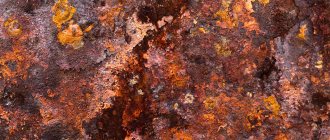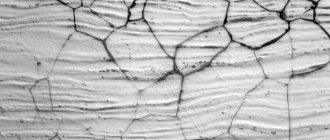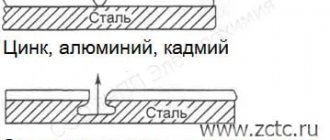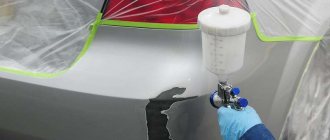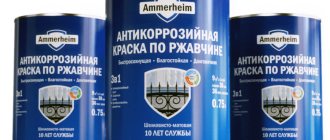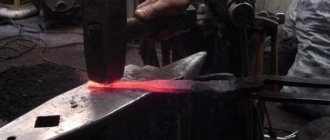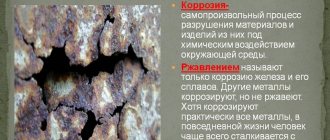Pitting (pitting) corrosion is a type of corrosion destruction that exclusively affects passive metals and alloys. Pitting corrosion is observed in nickel, zirconium, chromium-nickel, chromium, aluminum alloys, etc.
With pitting (spot) corrosion, only certain areas of the surface are destroyed, on which deep lesions are formed - pitting (spot ulcers).
Pitting corrosion is observed when a metal or alloy is exposed not only to passivators (the surface is brought into a passive state, for example, an oxidizer), but also to activator ions (Cl-, Br-, J-). Pitting (pitting) corrosion occurs actively in sea water, a mixture of nitric and hydrochloric acids, ferric chloride solutions, and other aggressive environments.
The pittings are classified according to their sizes:
— micropittings (up to 0.1 mm);
— pittings (0.1 – 1mm);
- spot, ulcer (more than 1 mm).
Pitting can be closed, open or superficial.
Open pitting is clearly visible on the surface with the naked eye or under slight magnification. If there are a lot of open pittings, corrosion becomes continuous. In open pitting, the bottom of the pore acts as an anode, and the passive film acts as a cathode.
Closed pitting is a very dangerous type of corrosion destruction, because such damage cannot be seen with your own eyes; their presence can only be determined using special instruments. Closed pitting develops deep into the metal or alloy. Closed pitting can cause breakdown even in stainless steels.
Superficial pitting is a type of pitting that develops more in width than in depth, forming potholes on the surface of the metal or alloy.
External manifestation of pitting corrosion
There are various forms of destruction of metals. Pitting or pitting is one of these forms, which is localized defects on the surface of a metal. Most often, pitting corrosion occurs on stainless steel, aluminum and its alloys, titanium, nickel and occurs when the passive state of the material is partially disrupted.
Pitting is quite dangerous for metal, despite the small size of its manifestations. The rest of the surface continues to remain in normal external condition, and only in some places white or reddish small dots, ulcers, and small stripes appear. Their appearance is deceptive and their depth is usually considerable, yet the user rarely notices them at an early stage of development.
The difference between stainless steel and plain steel
The first thing you need to know about stainless steel is that there are countless compositions on the market. What distinguishes them from a simple steel alloy (besides having different metal components in different proportions) is the protective oxide layer on the surface. As long as it remains intact, the metal will retain all its strength characteristics. But why does an oxide layer form on the surface of stainless steel? The answer lies in the specific elements used in most of its types: iron, manganese, silicon, carbon and chromium. Some grades also add nickel and/or molybdenum to further improve the characteristics of the oxide layer. Of the elements listed above, chromium has the greatest influence on the resistance of stainless steel to rust. This means that alloys with a high chromium content have the highest overall resistance to corrosion, since when they react with oxygen atoms, the chromium atoms form a dense oxide layer that prevents further reaction. Special additives, such as molybdenum, increase the alloy's resistance to certain aggressive chemicals. For example, 316 stainless steel contains molybdenum, which is not found in 304, so it is more resistant to chlorides.
Reasons that initiate pitting
Often the prerequisite for the appearance of pitting corrosion is a violation of metal production technology. For example, if casting rules are not followed, microimpurities and inclusions appear in steel that change the normal structure. Low-quality metal may be too porous or residual scale may appear in it - this also contributes to the occurrence of pitting.
Pitting also occurs when steel and other metals are used in an aggressive environment: solutions containing oxidizing agents and activating anions (hydrochloric, nitric acids, sea water, chloride compounds).
Other causes of pitting corrosion are:
- mechanical impact leading to chips, scratches and causing damage to the outer protective film;
- excessive internal stress of the metal;
- operation of the product at high temperatures.
Pitting corrosion is more likely to appear on rough stainless steel than on smooth, polished steel, so uneven surface texture is also considered a risk factor.
Details
Reasons for appearance
We propose to consider the main causes of pitting corrosion.
- Mechanical deformation
This could be a scratch, a dent, cracking in the area of impact, or more. This factor will be key because most metal alloys have a very thin, but still protective layer on the surface that helps prevent corrosion. Naturally, if such a layer is damaged, the metal will become unprotected from rust.
- Structural heterogeneity
This factor is also extremely important, because inhomogeneities will often create small pockets where rust will begin to appear after a while. Inexperienced engineers may think that such a factor will only be dangerous for low-quality metal and steel, but this is not at all the case. Indeed, low-quality alloys will have a heterogeneous structure and rust much more often, but structural heterogeneity can also appear in parts that have been processed and on which they forgot to apply a protective coating. A simple example - while drilling a hole, the integrity of the outer film against corrosion will be compromised - this will draw attention to the appearance of damage.
- High degree of roughness
If the surface of a metal object is very rough, then in such a case it is unlikely that a special anti-corrosion coating will adhere to it. For this reason, corrosion will appear on such a surface, but this is only a matter of time. Also pay attention to the fact that one rule will apply here - the greater the roughness of the metal surface, the sooner it will become covered with corrosion. Smooth, uniform metal will have excellent rust resistance.
- Aggressive environment
Believe it or not, even pitting corrosion of stainless steel can occur if there is contact with aggressive media (acids, water with a high content of salts, alkalis, etc.). Aggressive environments can also damage the outer anti-corrosion layer, and this can lead to pitting over time. Also note that different substances will affect the metal in different ways - if sea water does not cause any damage in short-term contact, but if it comes into contact with strong acids, severe damage may occur. For this reason, the rules for storing and processing metal should be observed.
Stages of pitting corrosion
The main danger of such corrosion will be rapid spread. The whole point is that as rust appears, the protective outer layer will be destroyed, and therefore such corrosion cannot be localized in a specific area. Even the smallest fragments grow and increase in size, and in the absence of timely treatment, corrosion will very quickly completely capture the metal, which will make it useless and to some extent dangerous (for example, when it comes to a suspended metal structure).
Such corrosion on the metal will spread in several stages:
- Spot rust begins to appear in places where the anti-corrosion coating is damaged (cracks, scratches, dents, etc.), and even when the metal structure is heterogeneous. Another localization will be treated metal, which for some reason did not have time to apply a protective coating.
- At the chemical level, this will happen like this - activator ions, under the influence of electrochemical force, will begin to displace oxygen from the oxide film that covers the metal sheet or product. This will lead to the gradual destruction of the outer metal coating with the appearance of characteristic ulcers and reddish-brown stains.
- As the oxide film deteriorates, rust begins to capture new areas of the surface of a metal object, this can lead to a deterioration in physical properties (hardness/density/strength is lost, etc.). The oxidation reaction will proceed according to the electrochemical scenario due to the displacement of oxygen from the oxide film.
- After the oxide film is completely destroyed, pitting will begin to penetrate into the metal alloy - and then the diffuse stage will begin. The speed of such a process will be quite low, and complete rusting can take a huge amount of time.
It is worth paying attention to the fact that sometimes spontaneous passivation of the metal will occur, which will lead to a slowdown in the appearance of rust. In practice, this scenario is very rare, although similar cases can be found in practice. It is worth paying attention to the fact that if pitting corrosion passes to the diffuse stage, passivation will not be possible for physical reasons.
Classification
There are several types of pitting:
Surface. In this scenario, the rust will begin to exclusively affect the top metal surface. It will also spread in the form of small and thin lines with a diameter of 0.1 to 0.3 cm. Surface rust at the initial stage will usually affect the corners, but after a while it will begin to spread horizontally across the entire surface of the metal element.- Open. In such a scenario, corrosion will begin to appear in the form of frequent large points, and their diameter will be from 0.2 to 0.5 cm. Several points will first appear on the surface, which are located far from each other. Over time, the number of points will increase in direct proportion, and they will begin to capture the entire surface of the metal object.
- Closed. In such a scenario, pitting will first capture the inner surface of the metal film, and the spread of corrosion usually occurs in the form of short lines or large circles with an average diameter (from 0.5 to 1.5 cm). This scenario will occur extremely rarely, and is the most dangerous, as well as disastrous, due to the difficulty of timely detection. Such corrosion will only appear at a late stage of corrosion growth, when the metal cannot be saved.
And now a little about how to protect objects.
Protection of metal objects
The main method of protecting stainless steel and metal from pitting type corrosion is passivation. For processing, a special solution based on citric and nitric acid is usually used. If necessary, the acid solution can be enhanced with various auxiliary additives. Certain engineers add ferrocyanide to the potassium solution at a concentration of 2.5%. The purpose of passivation is to slow down corrosion until no new rust appears. This acidic solution will act as a new protective film that will form on the surface during the process.
In addition, you can use other auxiliary protective measures:
- Sealing defects and cracks. One of the main reasons for the appearance of corrosion will be a violation of the integrity of the oxide film due to external defects. If such damage is repaired in time, then rust will not have time to appear.
- Removing roughness and irregularities. Rust very often appears on an uneven surface, and cleaning the metal surface will reliably protect the element.
- Application of chrome plating. Certain types of steel can be protected by applying an additional chrome-based coating, and this element will also prevent rust.
We hope this makes it easier for you to protect your metal parts.
Features and development pattern of pitting corrosion
Pitting has a high flow rate. If you do not get rid of minor defects in time, the product may rust through. The higher the temperature at the location of the metal, the faster it will rust.
Pitting corrosion develops in three stages:
- The first stage is emergence. Typically occurs in areas where protection has been compromised, where the passive film on the metal surface has been torn, or where there is material heterogeneity. After oxygen is displaced by activator ions, the oxide layer is destroyed.
- The second is the growth of pitting. It obeys the laws of electrochemical reactions. Due to the dissolution of the oxide film, the anodic process intensifies at the site of pitting corrosion, while the normal surface becomes a cathode.
- The third is diffuse expansion. At this stage, the corrosion element moves deeper, and new rust spots may form nearby.
In some cases, pitting stops developing at the second stage and moves to the repassivation stage. This happens when the reaction shifts towards passivation, for example, when the acidity of the medium changes. If pitting corrosion has progressed to the stage of diffuse growth, it can no longer enter repassivation.
Metal destruction scheme
To activate pitting corrosion, the presence of two reagents is necessary - activators and passivators. The anions of chlorine, bromine, and iodine most often act as activators - they are found in most environments in which metal products are used. They are adsorbed on the surface of the metal and form soluble complexes with its components.
Passivators most often include water or a hydroxyl group. The destruction process itself proceeds according to the following scheme:
- Activator ions are adsorbed on the surface of the protective (oxide) film.
- The process of replacing oxygen ions with ions of the process activator occurs.
- A large number of soluble ions are formed, as a result of which the film is destroyed.
As a result, a potential difference arises on the surface of the material, which leads to the appearance of local currents, and a violent anodic process is activated. At the same time, activator ions move to the sites of destruction, which is why pitting corrosion progresses.
Pitting shape
From the photo you can see that some elements have the correct shape, others are incorrect in appearance. The exact shape depends on the voids in the crystal lattice that formed during pitting initiation. Typically, irregular pitting corrosion occurs on plain (carbon), low-alloy steel and stainless steel, while correct pitting occurs on aluminum and various alloys. In addition, the classification of pittings by shape looks like this:
- hemispherical, with a shiny, polished bottom;
- polyhedral;
- faceted, including those interconnected;
- in the form of complex polyhedra;
- pyramidal;
- prismatic.
Polished (hemispherical) elements are often found on aluminum, tantalum and titanium, as well as on cobalt and nickel alloys.
Pitting Resistance Equivalent Numerical (PREN)
The RREN indicator is for reference; it shows the tendency of different types and brands of stainless steel to develop pitting. The numerical equivalent of pitting resistance is used as a guide, but not as an absolute guide, for determining corrosion resistance.
Typically, molybdenum, chromium and nitrogen are the most resistant to pitting rust as alloying additives. The higher the RREN number, the more resistant the steel will be to pitting. Here is some background information on RREN:
| steel grade | RREN |
| 444 | 25 |
| 430 | 16 |
| 304 | 19 |
| 316 | 26 |
| 304LN | 21 |
| 904L | 36 |
| 316LN | 27,5 |
| SAF 2507 | 42 |
| Zeron 100 | 41 |
Pitting classification
Pitting corrosion is classified not only by shape, but also by other characteristics: size, specifics of its development.
By size
Depending on the exact composition of the metal, environmental conditions (temperature, acidity), the size of pitting corrosion can be different:
- microscopic (micropitting) – less than 0.1 mm;
- conventional (pitting) – 0.1-1 mm;
- significant (ulcer) – more than 1 mm.
According to the specifics of development
Pitting can be superficial, open or closed. Surface corrosion elements develop intensively horizontally, without affecting the deeper structures of the metal. They cause the appearance of clearly visible shallow potholes. Open pitting is visible to the naked eye or at a small size when magnified with standard optical equipment. This type of rusting often turns into complete rusting if a lot of pitting begins to appear on the surface.
Closed corrosion is considered the most dangerous in terms of the further safety of metal products. It is impossible to examine it without instruments, so the elements grow deeper into the metal, remaining unnoticed for a long time. It is the closed pittings that cause the formation of holes. If the initial signs of corrosion are not removed in time, the product will become unusable.
Processing factor
An important factor in the formation of rust is the type of surface treatment. So, for example, products with a smoother surface are much more resistant to rust than stainless steel products with a rough surface. The thing is that rough surfaces get dirty faster and require more care. If elements with a rough surface, made of 304 stainless steel, are used in the food industry or marine conditions, they will quickly fail, as they will quickly become covered with corrosion stains.
Methods of protection against pitting
There are a number of modern methods for preventing corrosion, and many of them are already used at the production stage of the car. However, due to long use and constant contact with aggressive reagents, old machines are susceptible to rust. Pitting often occurs on various car parts: bearings, gear teeth, and rust spots on the body are considered a common occurrence.
Pitting corrosion is often found on household items, including stainless steel. To protect metal, you can use mechanical and chemical methods, some of which are suitable for independent use.
Mechanical method
This method includes tips for removing existing rust using grinding, laser processing, as well as mechanical application of barrier coatings (including paints). The choice of coating type depends on the type of metal and its operating conditions. The technique of galvanizing or nickel plating is usually used, but in industrial settings chrome plating, plating with copper, silver, aluminum, tin, and cadmium is also practiced. The created film isolates the metal from the environment and prevents it from coming into contact with acids, oxygen, and chlorine, thereby extending its service life.
There are kits on sale for do-it-yourself galvanizing of metal. First, the part is cleaned of existing rust by processing it with converters. After half an hour, the products are washed off, the product is cleaned, polished, a layer of a special solution is applied and an electrode with a zinc tip is connected. After a certain time, a thin zinc film will be created on the metal surface, which will prevent rust from further destroying the material.
Chemical method
The main chemical method of getting rid of corrosion is the elimination of a closed system with solutions of alkalis, sulfates, and chromates. The principle of operation is to reduce acidity and shift the reaction towards alkaline, in which corrosion processes stop. It is only important to control the release of hydrogen, since this element itself increases the risk of pitting.
Unfortunately, it is impossible to completely eliminate the risk of pitting corrosion in everyday life. There is only a chance to weaken the influence of risk factors. It is better to use the product correctly right away and prevent the acidity of the environment from increasing, rather than extending its service life by several years.
Reasons for poor quality of galvanic coatings
Defects in the application of electroplating, which cause difficulties in production, can be prevented if you pay attention to a number of issues: selection of equipment for the preparation and application of electroplating, proper care of the equipment, periodic analysis of electrolytes, incoming inspection of parts to be coated.
The most serious types of marriage are:
- insufficient adhesion (swelling or peeling);
- pitting;
- surface roughness;
- heterogeneity of appearance.
Insufficient adhesion of galvanic coating
If the adhesion of galvanic coatings to the base metal is disrupted, the part, as a rule, has to be recoated or manufactured anew (with multilayer coating), which requires significant material costs. Therefore, the defective product must be carefully analyzed and the type of delamination determined: from the base metal or from the metal of the sublayer.
If insufficient adhesion is observed between the base metal and the coating, then it is most logical to look for the cause of the defect during the surface preparation process (see “How to prepare the surface of a part for coating”), having first checked the grade of the base metal for compliance with the design documentation.
The quality of the degreasing operation should be checked on a pilot batch of parts, which should be cleaned manually, achieving complete wettability of the surface, after which subsequent operations - etching and activation - should be carried out, having first checked the cleanliness of these solutions for the presence of contaminants (possibly replaced).
If the adhesion of the coating on the test batch is insufficient, analyze the main electrolyte for the presence of impurities. Clean the electrolyte from impurities in accordance with the existing technical process.
Peeling of the main coating from the sublayer (for example, nickel from copper) is possible in the following cases:
- insufficient washing after copper plating or pickling;
- if the copper underlayer is dried before nickel plating and has spots on the surface immediately before immersion in the nickel plating bath.
To prevent the appearance of poor-quality coatings, it is advisable to carry out regular tests for general adhesion: bending, tearing, impact and heating.
Pitting on the electroplated surface
Pitting can be characterized as small depressions in the coating, which are caused by the shielding effect of hydrogen bubbles released at the cathode in zinc and nickel plating electrolytes, where the current efficiency is less than 100%. This defect requires recoating or final rejection of the part.
Types of metal corrosion
The most common types of metal corrosion :
- Uniform – covers the entire surface evenly
- Uneven
- Electoral
- Local stains – individual areas of the surface are corroded
- Ulcerative (or pitting)
- Spot
- Intercrystalline - spreads along the boundaries of a metal crystal
- Cracking
- Subsurface
Main types of metal corrosion
From the point of view of the mechanism of the corrosion process, two main types of corrosion can be distinguished: chemical and electrochemical.
